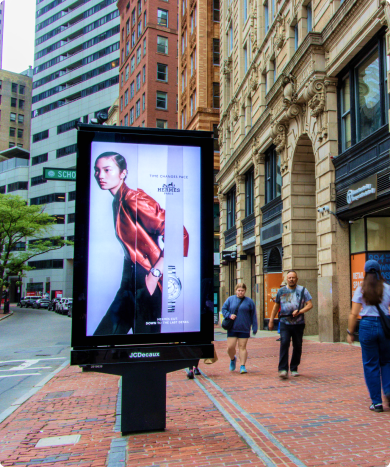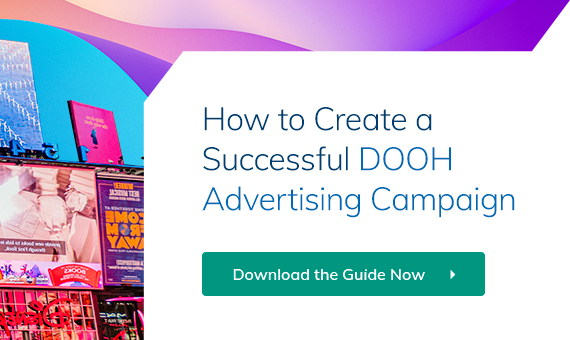Your Competitors Are Pitching Smarter. Here’s Why You’re Losing Creative Ground.
The Commercial Cost of Playing It Safe
Your agency isn’t losing work because your team lacks talent. You’re losing because your media playbook is stuck in 2018.
Static billboards that take weeks to change. Display ads that get blocked before they load. Instagram posts that blend into the noise.
Clients aren’t buying that anymore.
They want creative that moves literally. Context-aware, time-sensitive, and flexible enough to adapt mid-flight. And if you can’t offer it? You’re not just behind. You’re replaceable.
Programmatic Digital Out of Home (pDOOH) isn’t a media channel. It’s a positioning weapon.
It gives you the tools to win faster, charge more, and prove value beyond the concept deck.
pDOOH Is a Revenue System Disguised as a Creative Format
The smartest agencies aren’t selling “innovation.” They’re selling speed to impact.
pDOOH lets you:
- Launch faster: Upload and activate creative in hours, not weeks
- Target smarter: Adapt by time, location, audience behavior, or live data
- Test cheaper: Run creative variants and swap out underperformers mid-flight
- Charge more: Contextual, dynamic campaigns command premium rates
This isn’t about having fancier assets. It’s about owning the conversation in every pitch and delivering work that performs and impresses.
If Your Creative Process Hasn’t Changed, Neither Will Your Margins
Traditional outdoor was always a big canvas. But it was a slow one, locked into static buys, long lead times, and zero room to optimize.
pDOOH flips that.
You get the scale of traditional outdoor with the agility of digital and when paired with bold creative, it drives results your clients will feel in their sales reports.
But to pull this off, your creative system needs an upgrade.
Start by downloading the DOOH Creative Guidelines. It’s helped 500+ agencies avoid the expensive mistakes that tank campaign performance before launch.
The Framework Top Agencies Use to Win pDOOH Campaigns
1. Design for the Glance Economy
Your audience doesn’t care about subtlety. They have 3-5 seconds max. That means:
- One message per creative. No exceptions.
- Bold, high-contrast visuals.
- Immediate branding. No delayed reveals.
If your concept doesn’t register at 35mph, it doesn’t belong on a screen.
2. Use Motion to Drive Focus, Not Flash
Movement captures attention but only if it serves the message.
- Emphasize one element. Avoid visual noise.
- Use motion with restraint. Smooth > flashy.
- Keep files optimized for playback across screen types.
Creative that moves shouldn’t feel like a gimmick. It should feel inevitable.
3. Build Creative Systems. Not Just Assets
The agencies commanding the biggest pDOOH budgets think modular:
- Templates that swap offers, headlines, visuals by trigger
- Variations by time, location, weather, or audience context
- Pre-approved creative libraries that enable automated optimization
This is how you scale contextual campaigns without ballooning production hours or burning out your team.
4. Design for Context, Not Just Aesthetics
Where and when your creative appears matters as much as the message itself.
- Morning commuters need energy and speed.
- Late-night shoppers want comfort and ease.
- Transit hubs demand punchy clarity.
- Retail parks give you more dwell time and visual complexity.
Context isn’t a constraint. It’s a competitive advantage. The agencies winning with pDOOH are the ones designing for the moment, not just the brand book.
5. Test Relentlessly. Optimize Ruthlessly.
Here’s the edge of pDOOH: it lets you treat creative like a performance asset, not a sunk cost.
- A/B test visuals, tone, CTAs without extra media spend
- Use real-world feedback loops like foot traffic, search lift, or mobile proximity data
- Swap underperforming variants mid-campaign without a production scramble
This isn’t theoretical. It’s measurable. The agencies that embrace this test-and-optimize mindset are closing bigger deals and renewing faster.

DOOH: How it works
Time Sensitive Precision
A boutique agency won their biggest QSR client by rotating breakfast, lunch, and dinner messaging by time of day.
Result: 28% increase in footfall during targeted hours.
Takeaway: Timing isn’t just a media tactic it’s a creative unlock.
Reactive Campaign Mastery
A sportswear brand’s pDOOH campaign pulled live game scores into screens during key matches. Fans noticed. So did the client.
Result: 45% spike in engagement compared to static creative.
Takeaway: Relevance creates shareability and social buzz the brand didn’t pay for.
The pDOOH Advantage: Why Leaders Move Now
Top-tier agencies aren’t playing with pDOOH. They’re building their next growth engine on it.
Retention: Clients stay when campaigns feel smart, adaptive, and results driven.
Margins: pDOOH creative commands 15–30% higher pricing than static formats.
New Business: Dynamic campaign capability is now a pitch-deciding differentiator.
Talent: Top creatives want platforms that showcase their thinking, not just design.
If your competitors start showing up with this system and you don’t, you’re no longer in the same league.
Getting Started: Your Roadmap to DOOH Leadership
You don’t need a full team reorg to add pDOOH to your media stack. You need a focused test, the right structure, and a bias toward execution. Here’s the playbook.
Phase 1: Train and Audit
Set the foundation before you launch.
- Brief your team on how pDOOH works, targeting, creative format, and scheduling logic
- Audit your current creative assets for modularity, clarity, and adaptability
- Identify internal owners: who builds, who approves, who optimizes
- Use the DOOH Creative Guidelines to align on motion specs, timing, and screen requirements
This removes 90% of the bottlenecks before you commit media spend.
Phase 2: Pilot and Prove
Start small but make it a win.
- Choose one client open to testing new formats and rapid iteration
- Focus on a single city or cluster of 3–5 high-traffic screens
- Build two creative variants using contextual triggers (e.g., time-of-day or weather)
- Set simple, clear KPIs: search lift, foot traffic, engagement uplift
The goal here isn’t scale its proof. Something you can point to in pitches and performance reviews.
Phase 3: Scale and Systematize
Make pDOOH a core revenue driver.
- Create reusable creative templates to speed up campaign launches
- Build a bank of pre-approved creative variations to unlock mid-flight swaps
- Add pDOOH into every pitch and proposal as a premium media solution
- Equip your account team to sell it: not just as “outdoor with motion,” but as the agency’s edge in performance-based creative
This is how you turn one campaign into a growth lever across your entire client portfolio.
Fast-Track Checklist for Founders
- Identify your pilot client
- Assign creative and media leads
- Download and distribute the DOOH Creative Guidelines
- Book a demo with The Neuron team
- Launch your first pDOOH campaign within 30 days
Your competitors are still pitching static. You can start proving impact on strategy calls, in campaign performance, and in your P&L.
Book a Demo, Close Bigger Deals
You don’t need more decks, more guesswork, or more static ideas.
You need a media capability that wins you work, proves performance, and future-proofs your agency.
Book a demo with The Neuron and launch your first pDOOH campaign in days not months.
Don’t just pitch creative. Sell outcomes. Own attention. Close faster.


